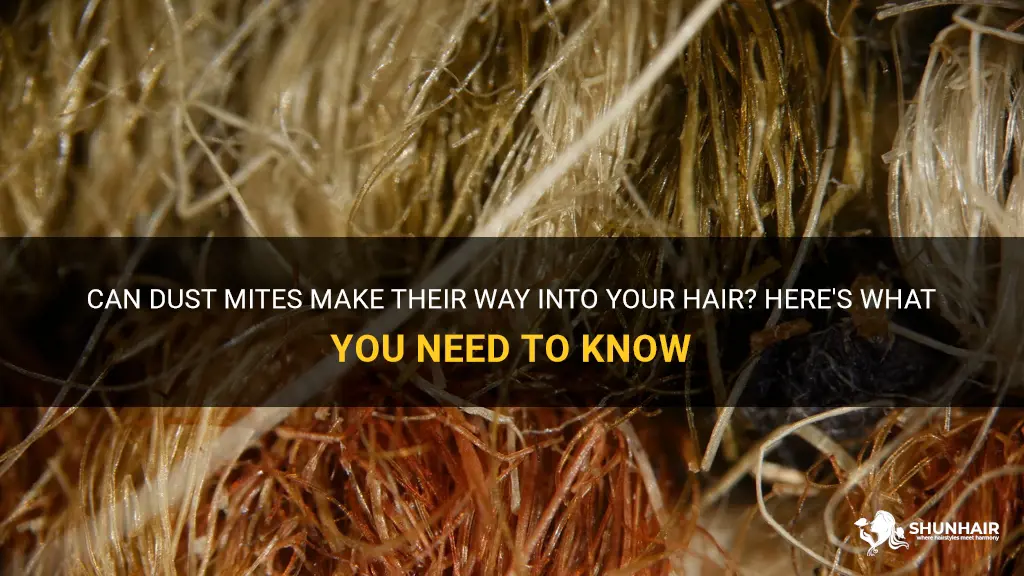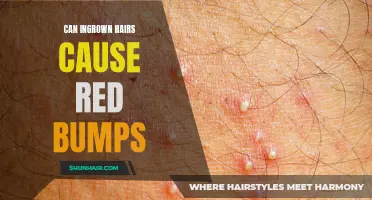
Did you know that you may have some tiny, unwelcome guests living in your hair? Dust mites, those microscopic creatures that thrive in warm and humid environments, can actually make their way into your hair and scalp. While they are harmless for most people, the thought of having these critters in your hair might still leave you feeling a bit unsettled. So, let's delve into the world of dust mites to learn more about their connection to our hair.
| Characteristics | Values |
|---|---|
| Size | 0.2-0.3 mm |
| Color | Translucent off-white to white |
| Habitat | Bedding, upholstered furniture |
| Diet | Dead skin cells |
| Lifespan | 2 to 4 months |
| Reproduction | Lay up to 40 eggs per day |
| Allergies | Can cause allergic reactions |
| Distribution | Worldwide |
| Preferred Climate | Warm and humid environments |
| Survival Conditions | Need moisture and humidity |
What You'll Learn

Can dust mites live in human hair?
Dust mites are microscopic organisms that are commonly found in bedding, carpets, and upholstery. They thrive in warm, humid environments and feed on dead skin cells shed by humans and pets. While dust mites primarily inhabit these areas, they can also be found on clothing, stuffed animals, and other surfaces.
However, it is highly unlikely for dust mites to live in human hair. Unlike bedding and carpets, human hair is not an ideal environment for dust mite infestation. This is mainly because dust mites prefer materials with high fiber density and moisture content. Hair, on the other hand, does not meet these criteria.
Dust mites are equipped with specialized mouthparts that allow them to easily navigate through the fibers of fabrics like bedding and carpets. These surfaces provide plenty of spaces for dust mites to burrow and reproduce. Human hair, on the other hand, does not have the same structure as bedding and carpets, making it difficult for dust mites to establish a habitat.
Additionally, dust mites require a continuous source of food to survive. They primarily feed on dead skin cells and dander, which are not present in human hair. Human hair is composed of keratin, a protein that does not serve as a food source for dust mites. Therefore, even if dust mites were to come into contact with human hair, they would not be able to sustain themselves.
In rare cases, dust mites may be found in hairbrushes or combs. This is because these items can accumulate dead skin cells and other debris, providing a suitable environment for dust mites to thrive. However, this does not mean that dust mites are living in the actual hair strands.
If you are concerned about dust mites or other allergens, it is important to focus on maintaining a clean and dust-free environment in your home. Regularly vacuuming carpets and upholstery, washing bedding in hot water, and using hypoallergenic pillow and mattress covers can help reduce dust mite populations.
In conclusion, dust mites do not typically live in human hair. While they are common in bedding and carpets, human hair does not provide the necessary environment or food source for dust mite infestation. It is important to maintain a clean and dust-free environment to minimize the presence of dust mites and other allergens.
Cutting Hair with Fabric Scissors: Can it be Done?
You may want to see also

How do dust mites get into hair?
Dust mites are microscopic organisms that can be found in almost every household. They are highly adaptable creatures that thrive in warm and humid environments, such as bedding, carpets, and upholstery. While dust mites primarily feed on dead skin cells and other organic matter, they can also find their way into hair.
Here's a step-by-step explanation of how dust mites can get into hair:
- Contaminated Surfaces: Dust mites can be found in various places throughout the house. When hair comes into contact with these contaminated surfaces, it can pick up the mites along with any allergens they may carry.
- Transfer from Hands: People often touch their hair unconsciously throughout the day. If their hands have come into contact with dust mite-infested surfaces, they can inadvertently transfer the mites to their hair.
- Airborne Particles: Dust mites produce waste products and shed their skin, which can become airborne. These particles can settle on hair, especially if the individual spends extended periods of time in dusty environments.
- Pillow and Bedding: Dust mites thrive in bedding, particularly pillows and mattresses, where they feed on dead skin cells and human hair. If someone with dust mite-infested bedding rests their head on the pillow, the mites can easily transfer to their hair.
- Pets: If you have pets that spend time indoors, they can also be carriers of dust mites. Their fur can harbor mites, and when they rub against your hair or you come into contact with them, the mites can easily move from their fur to your hair.
It's important to note that most people are not directly affected by the presence of dust mites in their hair. However, for individuals with allergies or sensitivities to dust mites, the presence of these microscopic creatures in their hair can trigger allergic reactions and discomfort.
To minimize the risk of dust mites getting into your hair, here are some preventive measures you can take:
- Regularly clean and vacuum your home to reduce dust mite populations.
- Wash bedding and pillowcases in hot water (at least 130°F) to kill dust mites.
- Use allergen-proof covers for mattresses and pillows to create a barrier against dust mites.
- Avoid lying down or resting your head on dusty surfaces.
- Brush or comb your hair frequently to remove any dust or allergens that may have accumulated.
In conclusion, dust mites can find their way into hair through various means, including contact with contaminated surfaces, transfer from hands, airborne particles, and contact with pets. While most people are not directly affected by dust mites in their hair, individuals with allergies or sensitivities should take preventive measures to minimize their exposure.
Determining Whether You Have Thick or Thin Hair: A Guide for All Hair Types
You may want to see also

Can dust mite allergies cause itching and discomfort in the scalp?
Dust mite allergies are a common problem that many people face. These microscopic creatures can cause a range of symptoms, including itching and discomfort. While dust mite allergies most commonly affect the respiratory system, they can also affect other parts of the body, including the scalp.
One of the main symptoms of dust mite allergies is itching. When a person with a dust mite allergy comes into contact with the allergens produced by these creatures, their immune system reacts by releasing histamines. These histamines cause inflammation and irritation in the skin, leading to itching.
The scalp is a common area that can be affected by dust mite allergies. Dust mites thrive in warm and humid environments, making the scalp an ideal breeding ground for these tiny creatures. When dust mites come into contact with the scalp, they can cause itching and discomfort.
In addition to itching, dust mite allergies can also lead to other scalp-related symptoms. Some people may experience redness, swelling, and even flaky skin on the scalp. These symptoms can be particularly bothersome and can impact a person's daily life.
If you suspect that you have a dust mite allergy and are experiencing itching and discomfort on your scalp, there are steps you can take to alleviate the symptoms. The first step is to reduce your exposure to dust mites. This can be done by regularly washing your bedding in hot water, using dust mite-proof covers on your pillows and mattress, and vacuuming your home frequently.
In addition to reducing exposure, there are also various medications and treatments that can help manage the symptoms of dust mite allergies. Over-the-counter antihistamines can help reduce itching and inflammation, while topical corticosteroids can provide relief for more severe symptoms.
In some cases, a person with a dust mite allergy may need to seek medical treatment. A dermatologist or allergist can perform tests to confirm the allergy and may recommend additional treatments, such as immunotherapy or prescription medications.
It's important to note that itching and discomfort on the scalp can also be caused by other factors, such as dry skin or scalp conditions like dandruff. If your symptoms persist or worsen despite taking steps to reduce dust mite exposure, it's best to consult a healthcare professional for an accurate diagnosis.
In conclusion, dust mite allergies can indeed cause itching and discomfort in the scalp. These microscopic creatures can infest the scalp and trigger an immune response, leading to symptoms such as itching, redness, and flaky skin. Taking steps to reduce dust mite exposure and seeking appropriate treatment can help alleviate these symptoms and improve quality of life.

What are the symptoms of having dust mites in your hair?
Dust mites are tiny creatures that live in dusty environments and feed on dead skin cells and other organic matter. While they are commonly found in bedding, carpets, and upholstery, it is possible for dust mites to also infest your hair. If you suspect you have dust mites in your hair, there are a few symptoms to look out for.
Itching and scalp irritation are common signs of dust mites in your hair. The mites themselves are too small to see with the naked eye, but their presence can cause intense itching, similar to a case of head lice. If you find yourself constantly scratching your scalp and experiencing discomfort, it could be a sign that dust mites have made a home in your hair.
Another symptom of dust mites in your hair is excessive dandruff. Dust mites feed on dead skin cells, and their presence can cause an increase in scalp flaking. If you notice an excessive amount of white flakes falling from your scalp, it may be an indication that dust mites are feasting on your skin cells and causing dandruff.
In some cases, dust mites in your hair can cause an allergic reaction. Some people are allergic to dust mite allergens, which are proteins found in their feces and body parts. When these allergens come into contact with the skin, they can trigger symptoms such as redness, swelling, and a rash. If you notice any of these symptoms along with the itching and dandruff, it is important to consult a healthcare professional for a proper diagnosis.
To confirm the presence of dust mites in your hair, you can try a simple DIY test. Take a small section of your hair and place it in a clear plastic bag. Leave the bag undisturbed for a few hours, and then examine it under a magnifying glass or microscope. If you see tiny moving creatures, it is a clear indication that dust mites are present.
If you discover that you have dust mites in your hair, there are several steps you can take to get rid of them. Firstly, make sure to wash your hair regularly with a gentle shampoo. This will help reduce the presence of dust mites and their allergens. Additionally, consider using a vacuum cleaner with a HEPA filter to clean your living environment and reduce dust mite populations.
It is also important to regularly wash your bedding and other fabrics that come into contact with your hair, as these can be potential sources of dust mites. Washing your bedding in hot water and using a dryer on a high heat setting can help kill dust mites and their eggs.
If your symptoms persist despite taking these measures, it is recommended to seek professional help from a dermatologist or allergist. They can provide a proper diagnosis and recommend specific treatments or medications to alleviate your symptoms and get rid of the dust mites in your hair.
In conclusion, while dust mites in your hair may not be as well-known as head lice, they can still cause discomfort and irritation. Itchy scalp, excessive dandruff, and allergic reactions are all potential symptoms of dust mites in your hair. By practicing good hygiene, regularly cleaning your living environment, and seeking professional help if needed, you can effectively manage and eliminate dust mites from your hair.
Learn How to Crochet Braids Without Cornrows for Versatile Hairstyles
You may want to see also

How can you prevent dust mites from going into your hair?
Dust mites are tiny creatures that thrive in warm and humid environments, such as our homes. They feed on dead skin cells and can cause allergic reactions in some people. While they are commonly found in bedding, carpets, and upholstered furniture, they can also find their way into our hair. Here are some steps you can take to prevent dust mites from going into your hair.
- Keep your living environment clean: One of the best ways to prevent dust mites from going into your hair is to maintain a clean living environment. Regularly vacuum your carpets and upholstered furniture to remove any dust or dead skin cells that may attract dust mites. Pay close attention to areas where you spend a lot of time, such as your bed and couch.
- Wash your bedding frequently: Dust mites love to live in bedding, so it's important to wash your sheets, pillowcases, and blankets regularly. Use hot water (above 130°F or 54°C) when washing to ensure that any dust mites present are killed. Additionally, consider using dust mite-proof covers for your mattress and pillows to create a barrier between you and the mites.
- Avoid laying on upholstered furniture: Dust mites can easily transfer from furniture to your hair, so it's best to avoid laying directly on upholstered surfaces. Instead, opt for sitting on chairs or using blankets or towels as a barrier between you and the furniture.
- Limit humidity: Dust mites thrive in humid environments, so it's important to keep the humidity levels in your home under control. Use a dehumidifier to remove excess moisture from the air, especially in areas prone to high humidity like bathrooms and basements.
- Keep your hair clean: Maintaining good hygiene practices for your hair can also help prevent dust mites from going into your hair. Wash your hair regularly using a mild shampoo to remove any potential allergens or dust mites that may have come into contact with your hair. Additionally, avoid using hair products that contain ingredients that may attract dust mites.
- Avoid sleeping with wet hair: Dust mites are attracted to moisture, so it's best to avoid sleeping with wet hair. Make sure your hair is completely dry before going to bed to minimize the chances of dust mites being attracted to it.
In conclusion, by following these steps, you can significantly reduce the chances of dust mites going into your hair. Keeping your living environment clean, washing your bedding frequently, avoiding laying on upholstered furniture, limiting humidity, and keeping your hair clean and dry are all effective strategies to prevent dust mites from becoming a nuisance in your hair.
Tips for Cutting Your Hair to Pass a Drug Test
You may want to see also
Frequently asked questions
No, dust mites typically do not live in hair. They are usually found in bedding, upholstery, and other soft surfaces where they can thrive in warm and humid environments.
No, dust mites do not cause hair loss. Hair loss can be caused by various factors such as genetics, hormonal changes, certain medical conditions, or excessive styling or treatments. It is unlikely that dust mites would contribute to hair loss.
To prevent dust mites from getting in your hair, it is important to maintain a clean living environment. Wash your bedding regularly in hot water, use hypoallergenic pillows and mattress covers, and vacuum and dust frequently. Additionally, try to keep your hair clean and tied up to minimize contact with any potential allergens.
If dust mites were to come into contact with your hair, it is possible that you may experience some itching or irritation. However, this is not a common occurrence as dust mites are not typically found in hair. If you are experiencing persistent itching or irritation on your scalp, it is best to consult a healthcare professional to determine the cause.
Yes, dust mites can cause allergies, but they are more commonly associated with respiratory allergies such as asthma and allergic rhinitis. The allergens produced by dust mites can trigger an immune response in some individuals, leading to symptoms such as sneezing, itching, and congestion. If you have a known allergy to dust mites, it is important to manage your environment to minimize exposure to their allergens.







